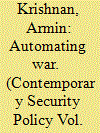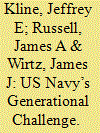|
|
|
Sort Order |
|
|
|
Items / Page
|
|
|
|
|
|
|
| Srl | Item |
| 1 |
ID:
087337


|
|
|
|
|
| Publication |
2009.
|
| Summary/Abstract |
New technological developments in the area of robotics and artificial intelligence have made robotic weapons systems of increasing autonomy possible. Although thousands of unmanned systems have been deployed, the vast majority are unarmed, used primarily for reconnaissance or removal of explosives. But deployment of armed robotic weapons has begun and promises to accelerate rapidly in the next decade. This article begins by proposing definitions of autonomous or robotic weapons, outlines the most important obstacles to their introduction, and options for arms control. It makes three claims: first, robotic weapons such as unmanned vehicles could largely replace human soldiers in the battlespace in one or two decades; second, for technical, economic, and operational reasons robotic weapons will become increasingly autonomous; finally, these new types of conventional weapons could result in new dangers to international security that should be addressed before the weapons are introduced and proliferate widely. It is suggested that an outright ban would be unlikely to be successful and that it may not even be desirable. A ban of particular types of offensive automatic weapons (AW) and special provisions on defensive types would make most sense.
|
|
|
|
|
|
|
|
|
|
|
|
|
|
|
|
| 2 |
ID:
179313


|
|
|
|
|
| Summary/Abstract |
Contemporary and future full-spectrum warfare would predictably be hybrid in nature, spanning into physical and conceptual dimensions — the former, a swift, intense and short-duration combat against an armed adversary and the latter, a sustained struggle for control and support of the domain of interest. Artificial Intelligence (AI) is fascinating as pursuit of machines to match human decision-making ability, albeit at a higher level of promptness and accuracy — both key components in tactical level of war fighting — hold vital promises for multi-dimensional warfare in fields of command and control, cyberspace, economic aggression, network centric operations, fail proof and predictive analysis of intelligence, deployment of autonomous unmanned platform, autonomous detection-acquisition-classification and engagement of targets, maintenance and upkeep of battle logistics and assets to name a few fields. This paper, while elaborating on conventional AI based force multipliers, also suggests futuristic unexplored application of AI to tilt the balance of power in own favour. The paper concludes with clear and non-utopian recommendation of future roadmaps, containing necessary change management and temporal action plan involving all stakeholders, to support India’s necessity to remain relevant in changing dynamics of warfare through development and deployment of AI and robotics.
|
|
|
|
|
|
|
|
|
|
|
|
|
|
|
|
| 3 |
ID:
155765


|
|
|
|
|
| Summary/Abstract |
In the face of rapid technological change and the creation of ambitious military modernisation programmes, this paper argues that land forces, in managing the relationship between force levels and the adoption of military robotics, must recognise that there are inherent limits to techno-centric force reduction efforts and realise the inefficacy of substituting skilled soldiers with robots. It begins with an overview of how the proper integration of robotics into a military’s force structure can improve capability, save lives and potentially reduce costs, but suggests that common accounts of robot utility are exaggerated and endanger the risk assessment processes governing the adoption of said technologies and relevant personnel settings. The paper explores the limits of robotic solutions to military problems, discussing their technical limitations, redundancy and related issues that, when combined with a technico-moral skills degradation problem also detailed within, point to the need to reshape force structures to suit the adoption of robotics while preserving existing levels of human staffing.
|
|
|
|
|
|
|
|
|
|
|
|
|
|
|
|
| 4 |
ID:
163835


|
|
|
|
|
| Summary/Abstract |
Developments in the field of social robotics have increasingly played with the boundaries between human and machine, using remote or tele-presence technological innovations as a way to mediate or revolutionize human-machine interactions. This paper explores one such development, namely the roboticization of care labour in the realm of education, and the ways in which it brokers relationships between human and non-human interaction. Drawing on fieldwork in the Philippines and South Korea and using the telepresence robotic innovation of Engkey as a case study, this paper describes practices that represent the convergence of technology, politics, and intimacies that shape the complexities of contemporary forms of labour migration, articulations of gendered and racialized “skill,” and changing relationships between human and non-human. The paper argues that these relationships are intentionally produced mediations of care: gendered and racialized hierarchies that produce new forms of affective labour and sociality that are governed by modes of simultaneous disembodiment and embodiment, immobility and mobility, and marketized statecraft through vocabularies of innovation and exploitation. These technologically produced mediations of care have implications for how we understand the connections between human and machine and how labour and sociality are ultimately brokered in the context of a neoliberal and capitalist world order.
|
|
|
|
|
|
|
|
|
|
|
|
|
|
|
|
| 5 |
ID:
186370


|
|
|
|
|
| Summary/Abstract |
Technological, social and environmental developments are producing changes at such a rate that they threaten to overwhelm the ability of individuals, societies and governments to adapt. The pace and impact of this technological churn is especially difficult for the US Navy because of the long time frames involved in traditional navy planning, acquisition and personnel cycles. The US Navy should prepare to ride succeeding waves of techno-strategic change – particularly the ‘robotics wave’ – and apply the rules of strategy in thinking about the role of technology in war at sea.
|
|
|
|
|
|
|
|
|
|
|
|
|
|
|
|
| 6 |
ID:
167674


|
|
|
|
|
| Summary/Abstract |
While the applications of artificial intelligence (AI) for militaries are broad, lethal autonomous weapon systems (LAWS) represent one possible usage of narrow AI by militaries. Research and development on LAWS by major powers, middle powers and non-state actors makes exploring the consequences for the security environment a crucial task. This article draws on classic research in security studies and examples from military history to assess the potential development and deployment of LAWS, as well as how they could influence arms races, the stability of deterrence, including strategic stability, the risk of crisis instability and wartime escalation. It focuses on these questions through the lens of two characteristics of LAWS: the potential for increased operational speed and the potential for decreased human control over battlefield choices. It also examines how these issues interact with the large uncertainty parameter associated with potential AI-based military capabilities at present, both in terms of the range of the possible and the opacity of their programming.
|
|
|
|
|
|
|
|
|
|
|
|
|
|
|
|
|
|
|
|
|